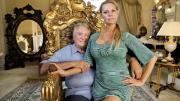When government professor Ryan Enos was growing up, gifts always came wrapped in a map. His father was a navigator for the U.S. Air Force, who used a sextant and paper map to help him fly around the world. “Subconsciously, I think this fascination with maps filtered into me,” Enos says. As a political scientist, he studies “social geography,” or the way that different racial or ethnic groups are organized in space (intermingled, segregated, or completely removed from one another), and how that affects politics. After graduating from Berkeley in 2001, Enos taught with Teach For America on the South Side of Chicago, a city that “in many ways was defined by segregation,” he says. “Segregation was this overwhelming experience in my kids’ lives.” It felt dramatically different from his hometown of Merced, California, “an incredibly diverse place, where you had this big influx of immigrants from Southeast Asia and Latin America.” Enos was struck by that contrast. How do such different social environments come to be, and how do they shape what people think about themselves and each other? When he started graduate school at UCLA, he thought he would study institutional politics: things like why Congress does what it does. But when it came time to begin serious research, he realized his real interest was the intersection of geography and race. His timing was auspicious: his career has coincided with a renewed interest in race in political science. Newly tenured, Enos says, “All of a sudden I’ve got my whole future ahead of me….How does that change what I work on? I’m still sorting that out.” And though he’s finally switched to GPS, he still keeps giant stashes of old maps, to wrap gifts for his students.
Social geographer Ryan Enos
Social geographer Ryan Enos
The political scientist explains “social geography.”

Ryan Enos
Photograph by Stu Rosner
You might also like
Eating for the Holidays, the Planet, and Your Heart
“Sustainable eating,” and healthy recipes you can prepare for the holidays.
Five Questions with Michèle Duguay
A Harvard scholar of music theory on how streaming services have changed the experience of music
Harvard Faculty Discuss Tenure Denials
New data show a shift in when, in the process, rejections occur
Most popular
Explore More From Current Issue

On Weekends, These Harvard Math Professors Teach the Smaller Set
At Cambridge Math Circle, faculty and alumni share puzzles, riddles, and joy.

This TikTok Artist Combines Monsters and Mental Heath
Ava Jinying Salzman’s artwork helps people process difficult feelings.






